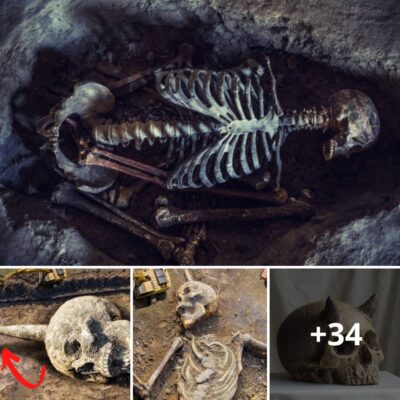Here, let’s take a look at 5 birds with the most unique courtship dance.
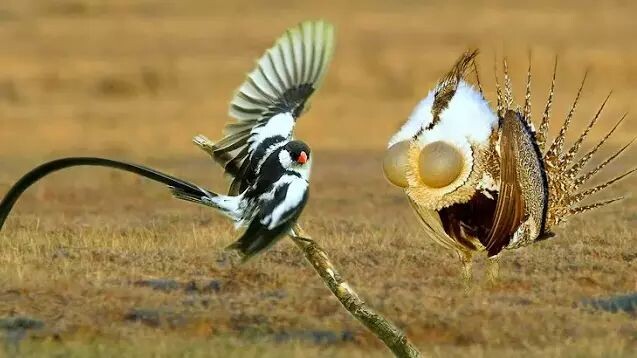
Hooded grebe (Podiceps gallardoi)
This waterfowl is found in the southern regions of Argentina. Here, they occur in isolated lakes in the most remote parts of Patagonia, and spend the winter along the coasts of the same region.
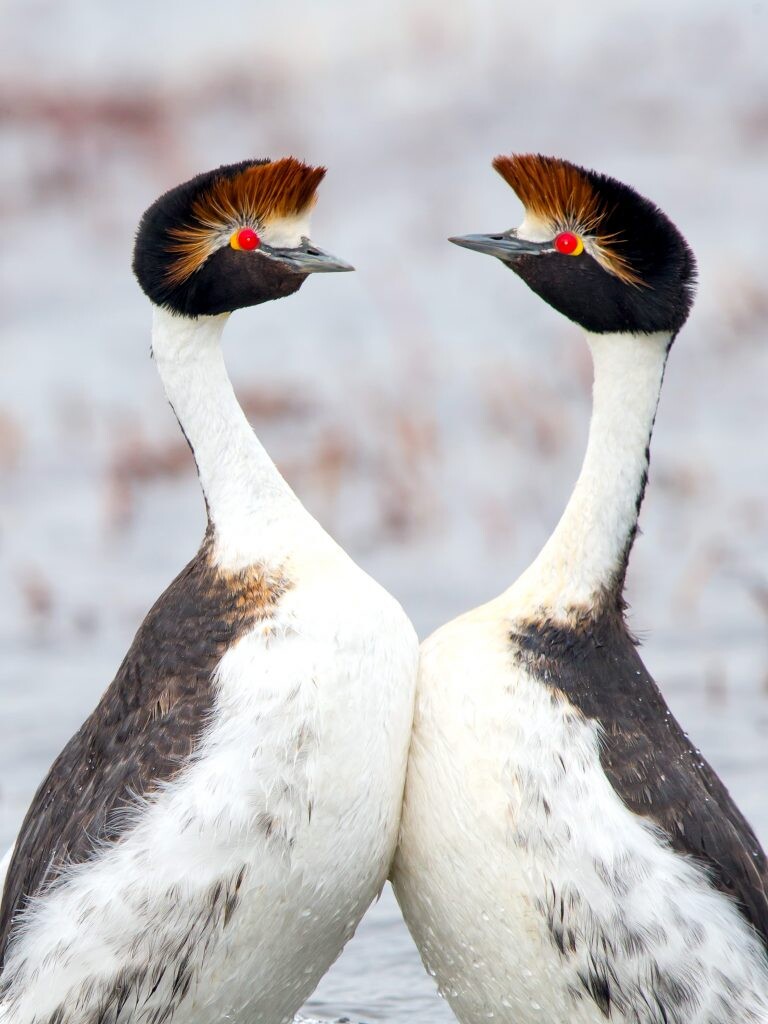
The hooded diving bird has a body length of about 32 cm, the plumage is black and white. The distinctive feature of this bird is the black hooded feathers, purple front part and a pair of fiery red eyes.
Moreover, during the breeding season, hooded diving birds put on an impressive performance. Unique and characteristic courtship dance of water birds. At this time, both couples will approach each other, chest to chest, head held high, turn to the left and then to the right, the two coordinate rhythmically to create an extremely attractive dance.
At all stages of life, hooded diving birds are susceptible to predation by the American mink. In addition, other factors such as habitat destruction, encroachment, entanglement, etc. have seriously threatened this wonderful bird. In 2012, the IUCN listed the hooded diving bird as endangered to critically endangered.
Wormwood
Greater Sage-Grouse (Centrocercus urophasianus) is a large North American bird found in the Sagebrush regions of the western United States, southern Alberta and Saskatchewan, Canada.
Adult males are 65 to 75 cm long and weigh from 1.8 kg to about 3 kg. The plumage has a yellow patch on each eye, gray on the head with white spots, dark brown neck, black belly. The tail is prominent with long – pointed feathers that rise up to the sky in the shape of a fan.
Wormwood is commonly found, in grasslands surrounded by sagebrush. They find and eat sagebrush and other plants, as well as insects.
What is remarkable about this bird, is its delicate courtship ritual during the breeding season. When spring comes, the male birds will gather and perform a very unique courtship dance.
The males gathered together, they stood upright, their pointed tails pointed to the sky in a fan shape. And the two strange balls in front of the chest began to work, they were inflated and deflated, accompanied by strange sounds, and the head and neck also moved with each rhythm, creating an extremely courtship ritual. unique.
Females will observe this performance, and choose for themselves the male with the most attractive dance to mate. After mating, the female will leave the ritual site to prepare to lay eggs.
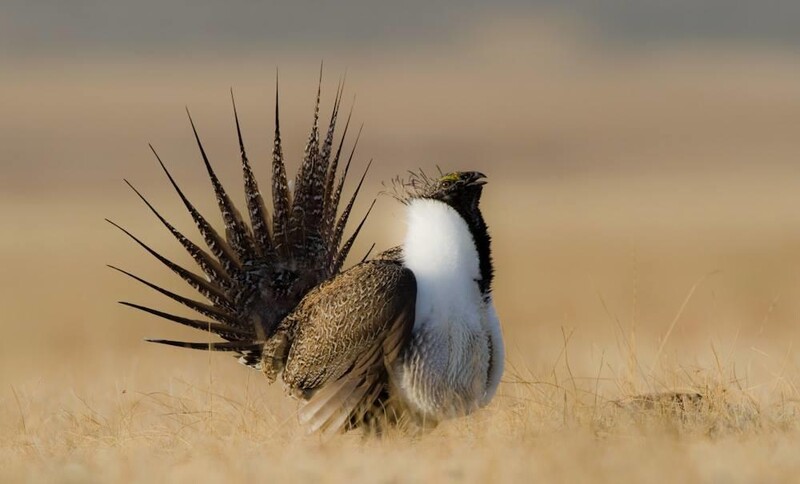
Wormwood, which is declining in its range due to habitat loss, is listed as threatened or near-threatened by international animal welfare organisations.
Blue-backed Manakin
The Blue-backed Manakin (chiroxiphia pareola) is a small finch found in the deciduous rainforests of South America, extending from Colombia to southeastern Brazil.
Although they have a small but quite plump body, with a body length of about 13 cm, a weight of about 19 g. Males are distinguished by their black plumage, accompanied by bright blue on the back and red on the head. Females and juveniles are predominantly olive green with pale underparts.

During the breeding season, the Blue-backed Manakin has a very attractive courtship display. An unusual thing here is that instead of competing for the female, they cooperate with each other to perform a beautiful wild dance, flirting with the female.
First, the leading male will perform a call, and the male birds in the area will gather to assist in performing the courtship dance performance. There are at least 2 and at most 8 males standing side by side on a horizontal branch.
They take turns, the male that is closest to the female, after dancing his dance part will fly to the farthest side, making room for the next male to come forward and dance his dance, accompanied by calls make a buzzing sound. The performance came to a climax, the leading male bird and the female bird flew away.
Only the leading male is allowed to mate with the female, the younger birds are learning from experience by performing dances to accompany the leading male. When the leader of the flock is old, the male birds in the flock will take turns to replace.
The Blue-backed Manakin has a fairly wide distribution, and is not as dangerous as other birds.
Flamingos
This Flamingos / Flamingos (Phoenicopterus) will be very easy to recognize because of its rather long neck and legs, plus its distinctively shaped beak.
Flamingos have pale pinkish-white plumage, part of their wing feathers is black, but this black color is only visible when they fly. The legs are pink, the eyes are yellow, the beak changes from white to pink, and the tip of the bill is black.
Flamingos have a flight speed of about 60 km/h, large flamingos have a height of 1.1 – 1.5 m and weigh about 2 to 4 kg.
Flamingos are highly social birds, they live in large flocks and have members in the thousands. There are even herds of up to 200,000 pairs.
With the breeding season approaching, both male and female will perform synchronized performances. That is, members of a group will stand together, raise their necks and make noises while their heads turn around. The whole group walked together in sync from side to side.
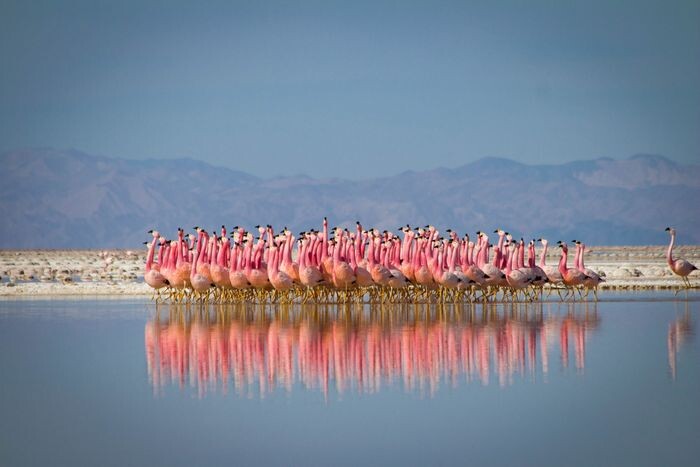
This performance does not appear to be directed at any one individual, but rather a random occurrence. This dance seems to have stimulated them to enjoy synchronized nesting and pairing with birds that have not yet had a mate.
Pin-tailed whydah
Pin-tailed whydah (Vidua macroura) this is a small bird with a long tail characteristic of males. This bird is mainly found in Africa, south of the Sahara.
The whydah has a body length of about 12-13 cm, the tail of the male can be 20 cm longer. The male has black plumage on the tip of his head, back, and long tail. The wings are dark brown with white patches, the remaining white appears on the neck and abdomen. The female has gray-brown plumage.

During the breeding season, the male whydah performs a rather special courtship dance performance. It will seek out where the female is perched, usually on a low branch. At this time, the male bird will perform the courtship dance. Along with its long tail, it hovers next to the female bird, its wings fluttering to the rhythm of descent and then rise again, creating a beautiful scene.
After the courtship dance, the couples mate but do not nest. They will lay parasitic eggs in the nests of other sparrows. Unlike birds in the cuckoo family, whydahs are egg-laying species, but they do not destroy host birds’ eggs.







